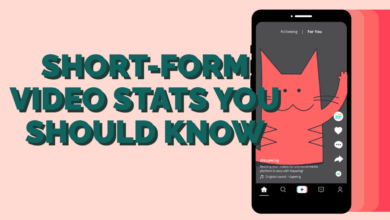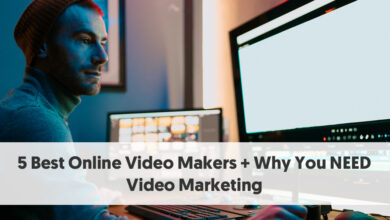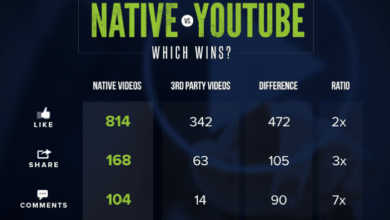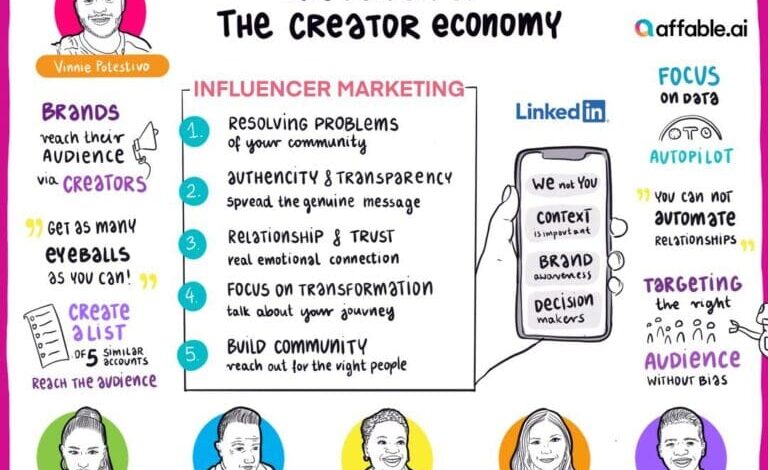
Creator Economy Marketing Explained A Deep Dive
Creator economy marketing explained is a rapidly evolving field that’s transforming how brands connect with audiences. It’s no longer enough to simply advertise; today’s successful strategies leverage the power of creators, from micro-influencers to established personalities, to build genuine connections and drive engagement. This in-depth exploration examines the key principles, strategies, and considerations for navigating the dynamic creator economy.
This comprehensive guide covers everything from defining creator economy marketing and understanding the ecosystem to crafting effective campaigns, optimizing content, measuring results, and navigating the legal and ethical landscape. We’ll explore the various types of creators, the platforms they use, and the metrics that matter most. Get ready to unlock the potential of this powerful marketing approach.
Introduction to Creator Economy Marketing
The creator economy marketing approach leverages the power of online creators to promote products and services. This strategy recognizes that creators, often with highly engaged audiences, offer a unique and authentic platform for reaching target demographics. It’s a departure from traditional, one-size-fits-all marketing methods, focusing instead on tailored engagement with specific communities.This shift from mass marketing to targeted, community-driven strategies is fueled by the rise of social media platforms and the increasing trust consumers place in recommendations from individuals they follow and admire.
Instead of impersonal advertisements, creator marketing often involves collaborative partnerships, where creators showcase products or services within their existing content streams. This authenticity resonates with audiences and drives genuine engagement.
Definition of Creator Economy Marketing
Creator economy marketing is a modern approach to promoting products or services through collaborations with online content creators. It emphasizes building authentic relationships and leveraging the creator’s existing audience to foster engagement and drive sales. This contrasts with traditional marketing, which often relies on broad-reaching advertisements.
Key Characteristics of Creator Economy Marketing
Creator economy marketing differs significantly from traditional marketing in several key aspects. It’s focused on building genuine connections, leveraging the creator’s unique brand voice and audience, and tailoring messages to specific communities. Traditional marketing, on the other hand, often relies on impersonal advertisements and broad-reaching campaigns. This targeted approach is one of the defining characteristics that sets creator economy marketing apart.
Another key difference is the shift from one-way communication to two-way engagement.
Understanding creator economy marketing is key to success, but finding the right tools is crucial. Mobile app developers looking to maximize their reach can benefit greatly from partnering with innovative social media marketing agencies, like innovative smm agencies for mobile app developers. These agencies can craft targeted strategies, boosting visibility and engagement for your app, ultimately leading to a stronger presence within the creator economy.
Evolution of Creator Marketing
Early creator marketing was primarily focused on influencers with large followings, often centered around social media. As the creator economy matured, the focus broadened to include a wider range of creators, from micro-influencers to niche experts. The evolution has also seen a growing emphasis on transparency and authenticity, recognizing that audiences value genuine recommendations over manufactured endorsements.
Examples of Successful Creator Marketing Campaigns
Numerous successful creator marketing campaigns have demonstrated the power of this approach. For example, a well-known cosmetics brand partnered with beauty vloggers to showcase new product lines. This strategy allowed the brand to reach a highly engaged audience of beauty enthusiasts, leading to increased sales and brand awareness. Similarly, gaming companies have successfully collaborated with streamers to showcase new game releases, attracting a dedicated gaming community.
These collaborations resonate deeply with their target audiences.
Creator vs. Influencer Marketing: A Comparison
| Feature | Creator Economy Marketing | Influencer Marketing |
|---|---|---|
| Focus | Building authentic relationships with creators across various niches, emphasizing community engagement and long-term partnerships. | Leveraging individuals with large followings to promote products or services through sponsored content. |
| Creator Type | Includes a wider range of creators, from micro-influencers to niche experts, focusing on the creator’s expertise and community. | Primarily focuses on individuals with established large followings. |
| Relationship | Collaborative partnerships, often emphasizing mutual benefit and shared values. | Often transactional, with a focus on the influencer’s compensation. |
| Engagement | Two-way communication, fostering community engagement and interaction. | Often one-way communication, focused on the influencer’s message. |
Understanding the Creator Ecosystem
The creator economy is a complex web of interconnected roles and relationships. Understanding these dynamics is crucial for effective creator marketing. From identifying the key players to navigating different creator types, this section dives deep into the intricacies of the creator ecosystem. Brands and marketers must understand this ecosystem to connect with the right creators and build successful campaigns.The creator economy is not just about individuals creating content; it’s about a vibrant, multifaceted ecosystem.
It involves creators, brands, agencies, and platforms working together, each with specific roles and responsibilities. Understanding these roles, how they interact, and the different types of creators allows for more targeted and effective marketing strategies.
Key Roles within the Creator Economy
The creator economy is a collaborative environment where several key roles interact. Creators produce content, brands seek to engage with audiences through creators, and agencies facilitate these connections. Each role plays a critical part in the overall ecosystem.
- Creators: Individuals who produce and share content across various platforms.
- Brands: Companies seeking to leverage creator content to reach target audiences.
- Agencies: Companies specializing in managing creator collaborations, often acting as intermediaries between creators and brands.
Types of Creators
Creators come in various shapes and sizes, each with a unique style and following. Understanding these distinctions is vital for aligning brands with the right creators for their campaigns.
- Niche Creators: These creators focus on highly specialized topics, often with a passionate, dedicated following. They tend to have smaller but highly engaged audiences.
- Macro Creators: These creators have large, established followings and are often well-known public figures. They offer a broad reach and influence.
- Micro Creators: These creators have a smaller following but are often highly engaged and relevant to niche audiences. They can be valuable for brands seeking a more focused approach.
Community Engagement in Creator Marketing
Community engagement is essential for fostering genuine connections between creators and their audiences. Active and responsive community management strengthens relationships and builds brand loyalty. A strong community is a vital asset for both creators and brands.A successful creator marketing strategy relies on fostering strong communities. Creators who cultivate a strong and engaged community build lasting relationships with their audience.
Role of Platforms in Facilitating Collaborations
Platforms play a crucial role in connecting creators and brands. They provide tools and resources for creators to showcase their work and for brands to find and engage with relevant creators. This streamlined connection is a key component of the creator economy.
Strategies for Discovering and Recruiting Creators
Finding the right creators for a campaign requires a strategic approach. This involves understanding the target audience, researching relevant creators, and identifying their strengths and weaknesses.
- Target Audience Research: Identifying the specific demographics and interests of the target audience provides insight into the types of creators who resonate with them.
- Platform-Specific Searches: Utilizing platform-specific search tools and filters to identify creators relevant to the campaign.
- Community Engagement: Actively engaging with creator communities on social media platforms and relevant forums.
Comparison of Creator Platforms
Different platforms offer varying strengths and weaknesses. This comparison table highlights these differences, providing a quick reference for choosing the most appropriate platform for a given campaign.
| Platform | Strengths | Weaknesses |
|---|---|---|
| Strong visual focus, large user base, influencer marketing tools | Limited text-based engagement, algorithm fluctuations can impact reach | |
| TikTok | High engagement rates, viral potential, short-form video focus | Algorithm-driven, may not be suitable for all brands |
| YouTube | Long-form video content, large audience potential, diverse creator types | Content creation takes longer, can be more complex to manage |
| Twitch | Gaming-focused, highly engaged audience, live streaming capabilities | Limited appeal for non-gaming brands, requires specific creator types |
Strategies for Creator Marketing Campaigns
Crafting a successful creator marketing strategy requires a deep understanding of the creator ecosystem and a nuanced approach to individual creators. It’s not a one-size-fits-all solution; tailoring campaigns to different creator types and aligning with their authentic brand voice is crucial for achieving meaningful results. This involves meticulous planning, clear communication, and a focus on measurable outcomes.Effective creator marketing goes beyond simply paying for posts.
It’s about fostering genuine relationships, understanding creator needs, and creating campaigns that benefit both the brand and the influencer. This symbiotic relationship, when nurtured correctly, leads to more impactful and authentic results.
Tailoring Campaigns for Different Creator Types
Different creators possess unique strengths and audiences. Recognizing these distinctions is paramount for crafting effective campaigns. Micro-influencers, for instance, often have highly engaged niche communities, making them ideal for targeted product launches or brand awareness campaigns. Macro-influencers, on the other hand, command a wider audience and can be instrumental in driving broader brand recognition. Understanding the creator’s specific audience, engagement style, and preferred content format allows for the development of campaigns that resonate deeply.
Consider the platform where the creator primarily operates. A TikTok influencer will likely engage with a different style of content than an Instagram influencer.
Campaign Metrics and KPIs
Measuring campaign success is crucial for optimizing future efforts. Common key performance indicators (KPIs) include reach, engagement (likes, comments, shares), website traffic, conversions, and sales. Analyzing these metrics helps in understanding campaign effectiveness and identifying areas for improvement. For example, if a campaign generates high engagement but low conversions, further investigation might reveal issues in the call to action or the product itself.
A thorough analysis of the data allows for iterative improvements to achieve desired results. Monitoring these KPIs in real-time enables proactive adjustments to optimize performance.
Measuring Campaign ROI in the Creator Economy
Calculating return on investment (ROI) in creator marketing is essential for demonstrating value and justifying future spending. This involves carefully tracking campaign expenses, including creator fees, platform costs, and other related expenses. Quantifying the value of the campaign’s outcomes, such as increased brand awareness, sales, or website traffic, provides a precise ROI calculation. A successful campaign is one that clearly demonstrates a positive return on investment, justifying the financial outlay.
A well-defined process for tracking expenses and measuring results is critical for achieving this.
Authenticity and Brand Alignment
Authenticity and brand alignment are paramount in creator collaborations. Creators who genuinely believe in the product or service they’re promoting are more likely to connect with their audience in a meaningful way. For brands, this means partnering with creators whose values and aesthetic align with their own brand identity. Brands that focus on these factors are more likely to generate positive and sustainable results, as opposed to superficial collaborations.
This authenticity fosters trust and credibility, ultimately enhancing brand reputation.
Creating a Campaign Brief for a Creator
A well-structured campaign brief provides the creator with all the necessary information to execute a successful campaign. It should include details about the brand, product or service, target audience, campaign goals, and desired outcomes. Clearly outlining the expectations and deliverables is vital for a smooth and productive collaboration. The campaign brief serves as a contract between the brand and the creator, ensuring a clear understanding of the campaign objectives.
Campaign Goals and Achievement Strategies
| Campaign Goal | Strategies for Creators to Achieve Goals |
|---|---|
| Increased Brand Awareness | Creating engaging content that aligns with the brand’s identity and resonates with the target audience. Utilizing relevant hashtags and engaging in platform-specific interactions. |
| Driving Website Traffic | Including clear and compelling calls to action in the content, directing traffic to a dedicated landing page or website. Creating a unique and memorable link for tracking purposes. |
| Generating Leads | Implementing lead generation forms or sign-up links within the content. Offering exclusive content or discounts in exchange for contact information. |
| Boosting Sales | Using promotional codes or unique discount links specific to the campaign. Creating a sense of urgency or exclusivity to encourage immediate purchases. |
Content Creation and Distribution: Creator Economy Marketing Explained
Crafting compelling content is the lifeblood of any successful creator marketing campaign. It’s the bridge between the creator and their audience, fostering engagement and building a loyal following. Effective content creation goes beyond simply producing something; it requires a deep understanding of your target audience and a strategy to resonate with them. Knowing your audience’s interests, pain points, and preferred content formats is crucial.This section dives into the specifics of crafting and distributing content that captures attention and drives results.
Understanding creator economy marketing is key to success. Knowing your target audience and crafting compelling content is crucial. But, to truly maximize your reach, consider the best time to post on LinkedIn, as it can significantly impact engagement. Optimizing your posting schedule, like finding the peak times for your audience on LinkedIn, is vital for boosting visibility.
whats the best time to post on linkedin This, in turn, helps you connect with potential collaborators and sponsors in the creator economy. Effective marketing strategies for creators are about understanding these nuanced details.
We’ll explore various content formats, optimization strategies, the importance of consistency, and distribution channels.
Engaging Content Production
Creating content that genuinely engages your audience requires a thoughtful approach. It’s not just about quantity but quality. Consider what problems your content solves or what questions it answers. High-quality content builds trust and establishes your creator as an authority in their niche. It’s about delivering value to your audience, fostering a connection, and prompting them to take action.
This could involve tutorials, insightful commentary, or entertaining stories.
Content Formats for Creator Marketing
Diverse content formats are essential for keeping your audience engaged. Videos, blogs, and social media posts each offer unique opportunities for interaction.
- Videos: Videos are a powerful medium for storytelling and showcasing expertise. Short-form video content, like TikTok or Instagram Reels, are exceptionally effective at capturing attention and driving virality. Longer videos, like YouTube tutorials or interviews, offer a platform for in-depth discussions and demonstrate mastery.
- Blogs: Blogs allow for detailed explanations and in-depth explorations of topics. They’re ideal for providing comprehensive guides, insights, and expertise, attracting a dedicated audience.
- Social Media Posts: Social media posts are crucial for maintaining a constant presence and engagement. They can be used to promote other content, drive traffic to your website, and spark conversations. They can be brief and visually compelling, with engaging captions and relevant hashtags.
Platform Optimization Strategies
Different platforms have different characteristics and audiences. Tailoring your content to each platform is essential for maximizing its reach and engagement.
- Understanding Platform Aesthetics: Platforms like TikTok favor short, visually-driven content, while LinkedIn thrives on professional insights. Understanding these platform aesthetics is crucial for tailoring your content to each platform’s unique strengths.
- Content Length and Format: The optimal length and format of your content vary significantly across platforms. Consider the attention spans of your target audience on each platform when determining content length.
- Research and Hashtags: Strategic use of relevant s and hashtags helps your content reach a wider audience on each platform.
Consistency and Content Calendars
A consistent content schedule is paramount for building a loyal audience and establishing a strong brand identity. It builds anticipation and reliability, leading to increased engagement.
- Content Calendars: Planning your content in advance, using a content calendar, ensures consistent delivery and helps you stay organized.
- Content Frequency: Regular posting keeps your audience engaged and interested. A defined schedule ensures a consistent stream of content.
Content Distribution Channels
Beyond your primary platform, consider leveraging other channels to expand your reach.
- Email Marketing: Nurturing email subscribers with valuable content keeps them engaged and informed.
- Collaboration and Cross-Promotion: Partnering with other creators or influencers can expand your reach and introduce you to new audiences.
- Paid Advertising: Leveraging targeted advertising on platforms can significantly expand your reach.
Content Creation Tools Comparison
Various tools streamline the content creation process. Here’s a comparison:
| Tool | Features | Pros | Cons |
|---|---|---|---|
| Canva | Graphic design, video editing, social media scheduling | User-friendly, affordable | Limited advanced features for professionals |
| Adobe Creative Suite | Comprehensive design and editing tools | High-quality results, extensive features | Expensive, steeper learning curve |
| CapCut | Video editing for mobile | Easy to use, great for quick edits | Limited advanced features compared to desktop software |
Measuring and Analyzing Results
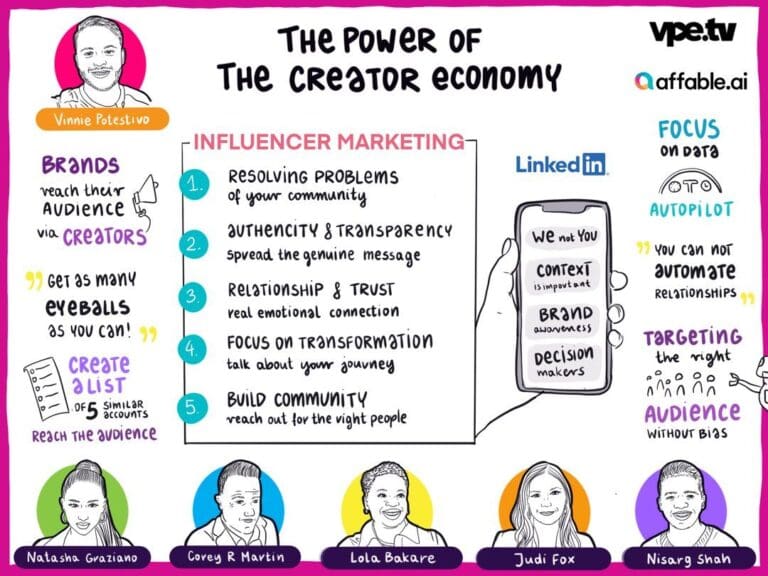
Tracking the performance of creator marketing campaigns is crucial for understanding what resonates with audiences and optimizing future strategies. A well-defined system for measuring and analyzing campaign data allows for a deeper understanding of the effectiveness of various tactics, enabling marketers to fine-tune their approaches for better returns. This data-driven approach fosters a continuous cycle of improvement, allowing campaigns to evolve and adapt based on real-time insights.Understanding the nuances of engagement, reach, and conversion rates provides invaluable insights into the effectiveness of the creator’s content and the overall campaign.
Analyzing the results, both positive and negative, helps in identifying trends, uncovering areas for improvement, and adjusting strategies for greater success. By implementing robust data analysis, marketers can make informed decisions that optimize campaign performance and maximize return on investment (ROI).
Methods for Tracking Campaign Performance
Several methods are used to track the performance of creator marketing campaigns. These include utilizing analytics platforms to monitor key metrics, examining social media engagement, and analyzing website traffic. A combination of these methods allows for a comprehensive understanding of campaign performance.
Metrics for Measuring Campaign Effectiveness
A variety of metrics are used to evaluate the effectiveness of a creator marketing campaign. Crucial metrics include engagement rates, reach, conversions, and impressions. Engagement rates, such as likes, shares, and comments, reflect audience interaction with creator content. Reach quantifies the number of unique users exposed to the campaign. Conversion rates measure the percentage of users who complete desired actions, such as purchasing a product or signing up for a newsletter.
Finally, impressions count the total number of times the content was displayed. By monitoring these metrics, campaign performance can be effectively evaluated.
Importance of Analyzing Campaign Data
Analyzing campaign data is essential for future improvements. Patterns and trends within the data can reveal what works and what doesn’t. This allows for iterative improvements in future campaigns, leading to better ROI and more effective strategies. Identifying areas for improvement and adapting to new trends are vital for maintaining campaign success. By closely examining the data, marketers can identify the strengths and weaknesses of their campaigns, allowing for informed decisions and more effective strategies.
Identifying and Addressing Issues
Analyzing campaign data can help identify and address issues that arise during a campaign. For example, low engagement rates may point to issues with content quality or creator alignment. Decreased website traffic could indicate problems with campaign messaging or distribution channels. By proactively addressing these issues, marketers can adjust their strategies and prevent further setbacks.
Utilizing Analytics Tools
Various analytics tools can monitor campaign progress. Social media platforms often provide built-in analytics dashboards. Third-party tools offer more comprehensive data collection and analysis capabilities, allowing for a deeper understanding of campaign performance. These tools provide insights into audience demographics, content preferences, and campaign effectiveness, enabling data-driven decision-making.
Data Analysis for Optimizing Creator Campaigns
| Data Analysis Type | Description | Example |
|---|---|---|
| Social Media Analytics | Tracks engagement, reach, and demographics on social media platforms. | Analyzing Instagram post engagement to identify popular content themes. |
| Website Analytics | Measures website traffic, user behavior, and conversion rates. | Tracking website traffic from social media campaigns to measure their effectiveness. |
| Sales Data | Examines sales figures to determine campaign impact on revenue. | Analyzing sales data from a creator’s product to assess the success of a campaign in driving sales. |
| Customer Feedback | Collects and analyzes customer reviews, surveys, and comments. | Analyzing customer reviews to understand what creators are saying about a product. |
Legal and Ethical Considerations
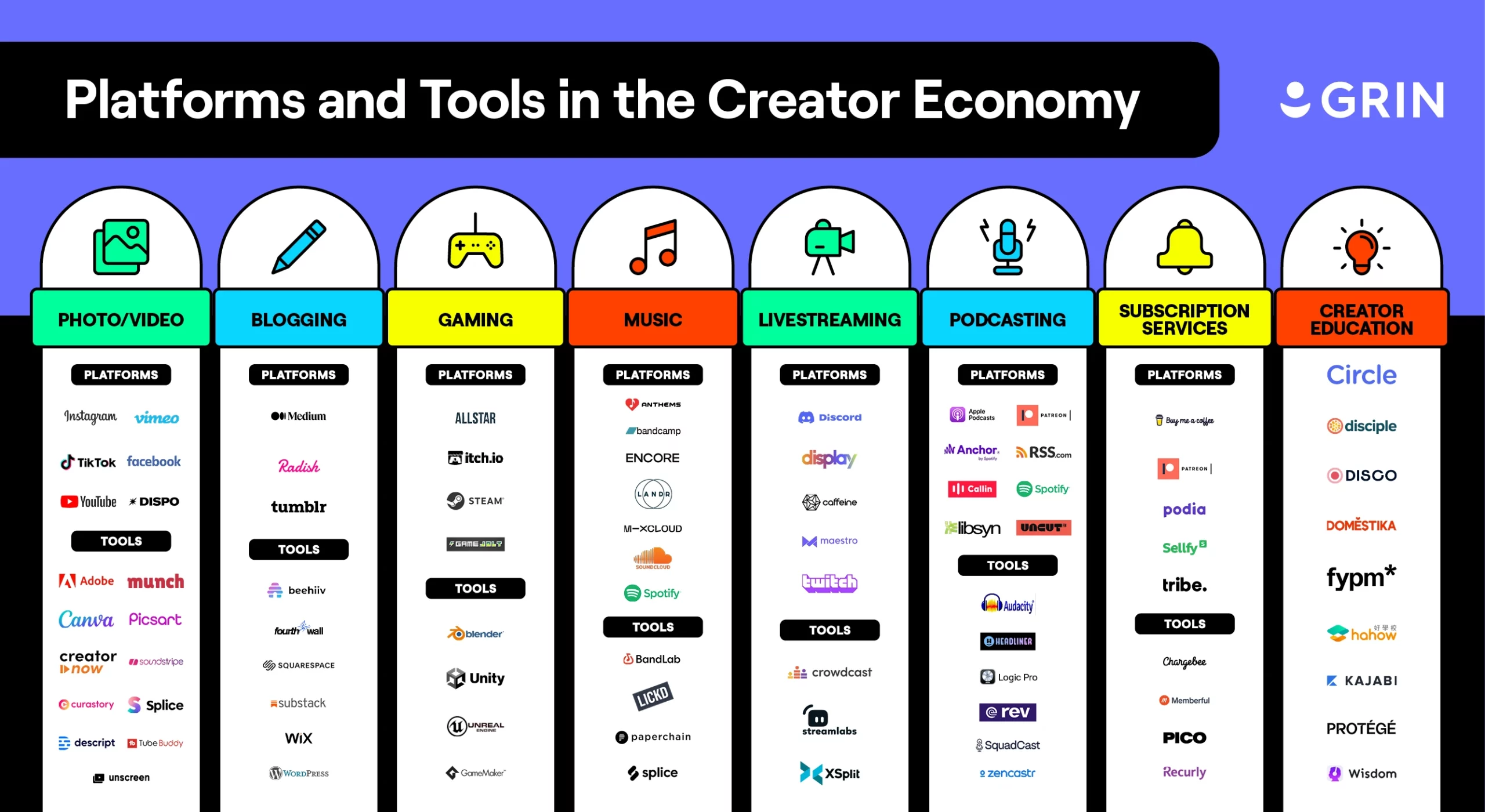
Navigating the creator economy requires a nuanced understanding of legal and ethical boundaries. Collaborations between brands and creators often involve complex issues, from disclosure requirements to intellectual property rights. This section dives deep into these considerations, offering practical guidelines for ethical conduct and maintaining transparency.
Disclosure Requirements, Creator economy marketing explained
Clear and upfront disclosure is paramount in creator marketing. Failure to disclose sponsored content can lead to reputational damage for both the creator and the brand. Audiences are increasingly savvy and expect honesty in sponsored posts. This includes explicitly stating when a post is sponsored and identifying the brand or product being promoted. Detailed disclosure policies vary by platform and jurisdiction.
Creators should consult legal counsel or platform guidelines to ensure compliance.
Ethical Conduct Guidelines
Maintaining ethical conduct is essential for building trust with audiences. Creators should prioritize authenticity and avoid misleading or deceptive practices. Using influencers’ reputations to sell products or services without their genuine belief can damage trust. Ethical guidelines also include avoiding harmful content, such as promoting products or services that are harmful to health or exploit vulnerable populations.
Creators should prioritize their values and brand image when collaborating with brands.
So, creator economy marketing explained boils down to understanding your audience and engaging with them authentically. A great way to do that is by utilizing TikTok auto captions, a feature that helps you reach a wider audience. Learning how and why to use TikTok auto captions how and why to use them can significantly boost your visibility, and ultimately, your success in the creator economy.
By focusing on these strategies, you’ll be well-equipped to thrive in this ever-evolving space.
Transparency and Trust Building
Transparency fosters trust between creators, brands, and audiences. Creators should clearly articulate their relationships with brands, outlining any potential conflicts of interest. Open communication builds trust and allows audiences to make informed decisions about the content they consume. Regularly updating audience members about creator partnerships helps build transparency.
Respecting Intellectual Property Rights
Creators own the rights to their content. Brands must respect these rights and ensure they don’t use creator content without permission. This includes obtaining necessary licenses for use in marketing materials. Respecting intellectual property rights safeguards the creative community and promotes fair compensation for creators.
Ethical Dilemmas and Solutions
Creator marketing often presents ethical dilemmas. One example is a creator promoting a product they don’t genuinely believe in. A solution is to clearly define the creator’s role and to ensure the creator’s genuine endorsement. Another dilemma is when a creator receives undisclosed incentives for promoting a product. Solutions involve transparent disclosure and ethical guidelines.
A creator promoting a product that could have harmful side effects without proper disclosure is another example. This requires a thorough understanding of the product and careful consideration of the potential impact on the audience.
Table of Legal and Ethical Considerations
| Category | Description | Examples |
|---|---|---|
| Disclosure | Clearly state sponsored content and identify the brand or product. | Using hashtags like #ad or #sponsored, clearly stating the collaboration in the post’s caption. |
| Ethical Conduct | Prioritize authenticity and avoid misleading or deceptive practices. | Promoting products or services the creator genuinely believes in, avoiding harmful content. |
| Transparency | Articulate relationships with brands, outlining any potential conflicts of interest. | Disclosing any financial incentives or personal connections related to the collaboration. |
| Intellectual Property | Respect creator content rights and obtain necessary licenses. | Obtaining permission to use creator-generated images or videos in marketing materials. |
Future Trends in Creator Economy Marketing
The creator economy is rapidly evolving, driven by technological advancements and shifting consumer preferences. This dynamic environment necessitates a proactive approach to marketing, adapting to emerging trends and technologies to remain competitive. Understanding the potential opportunities and challenges is crucial for creators and marketers alike.The future of creator marketing will be increasingly intertwined with emerging technologies, providing both unprecedented opportunities and complex challenges.
Adapting strategies and embracing innovation are essential for navigating this ever-changing landscape.
Emerging Technologies and Platforms
The creator economy is being reshaped by new technologies and platforms. This is impacting how creators build their audiences and monetize their content. Virtual and augmented reality (VR/AR) experiences, interactive streaming platforms, and decentralized social media are examples of game-changers. These platforms provide unique avenues for engagement and interaction, offering creators novel ways to connect with their audience.
Impact on Creator Strategies
The proliferation of new platforms necessitates strategic adaptation. Creators need to identify emerging trends and tailor their content to the specific characteristics of each platform. For example, creators leveraging VR/AR must produce engaging experiences that take full advantage of the technology. This may involve producing 3D content, immersive environments, and interactive elements. Creators should also consider building a multi-platform presence to maintain visibility and engagement across various audiences.
Adaptations to Changing Market Dynamics
The creator economy is not static. The changing market dynamics demand adaptability. Creators must remain informed about new trends, platforms, and technologies to maintain relevance. This includes staying up-to-date on audience preferences, emerging algorithms, and effective marketing strategies. Creators must continually evaluate and adjust their strategies to meet evolving demands.
Innovative Creator Marketing Approaches
Innovative creator marketing approaches are constantly emerging. Creators are experimenting with new ways to connect with their audiences. This includes using interactive content formats, incorporating personalized experiences, and leveraging the power of community engagement tools. Examples include live Q&A sessions, interactive storytelling, and gamified engagement mechanisms. These strategies can foster stronger connections with audiences and build loyal communities.
Potential Future Trends
| Trend | Description | Impact on Creators |
|---|---|---|
| Rise of Immersive Experiences (VR/AR) | Creators will use VR/AR for interactive content and experiences. | Creators can create immersive content, but require investment in equipment and training. |
| AI-Powered Content Creation | AI will assist creators in content generation and optimization. | Creators can leverage AI for efficiency, but need to maintain human creativity and engagement. |
| Decentralized Social Media Platforms | Social media platforms will become more decentralized and creator-centric. | Creators will have more control over their content and earnings, but require understanding of new platforms and technologies. |
| Focus on Community Building | Creators will prioritize community engagement and fostering relationships. | Creators can build loyalty and revenue through engagement and loyalty programs. |
| Personalized Content Delivery | Creators will deliver content tailored to individual preferences. | Creators need to collect and analyze audience data to create personalized experiences. |
Summary
In conclusion, creator economy marketing explained offers a compelling alternative to traditional advertising. By understanding the nuances of this ecosystem, brands can forge authentic connections with their target audiences, build trust, and achieve remarkable results. This guide has provided a roadmap for successfully navigating the complexities of creator marketing, equipping you with the knowledge and strategies to succeed in this ever-evolving landscape.
The future of marketing is in your hands!

